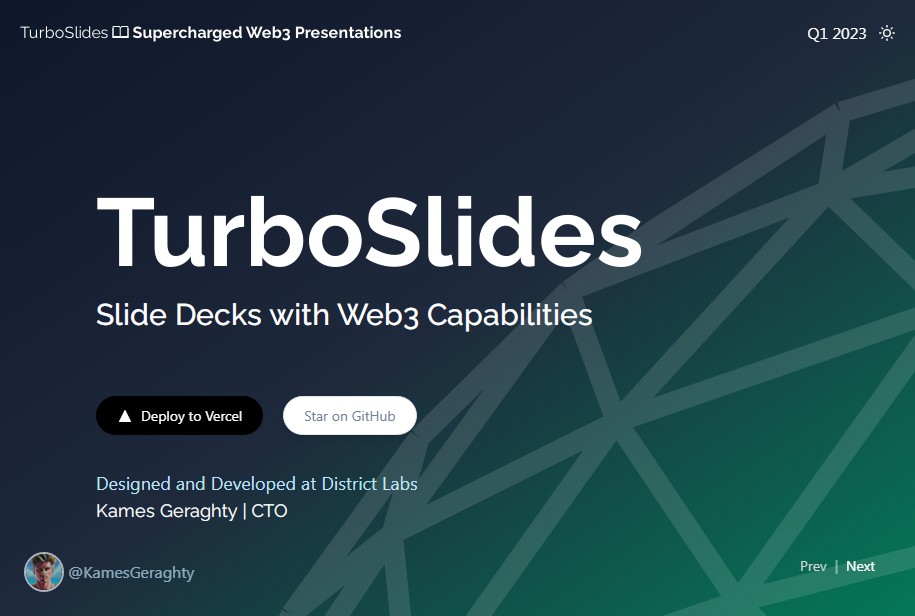
📖 Turbo Slides
Create presentation decks using MDX, React, and Next.js with Web3 capabilities
Features
- 📽 React-based Slideshow
- ✍️ Write using Markdown, React components, even HTML!
- 🎨 Themeable with Tailwind or Styled Components
- ♻️ Sync slides between browser tabs
- 👨💻 Presentation Mode
- 📝 Speaker Notes
Getting Started
- Clone the project: `git clone https://github.com/turbo-eth/turbo-slides
- Install dependencies:
npm ioryarn - Run the dev server:
npm run devoryarn dev - Edit the first slide in
/pages/index.mdxand save to see changes!
When you're done, run npm run build && npm run export or yarn build && yarn export will create a static app you can deploy anywhere (or use locally). See below for more details.
Deploying
This project is easy to build locally or using a host with build services (like Netlify or Now).
- ⚙️ Run the build process:
yarn export - 🚀 Upload the static contents of
outfolder to host/CDN (or run theout/index.htmllocally)
How to Use
💬 Changing the Title/Date/etc
The default theme includes a title, date, author (and link to the author's website) in of the site.config.js file.
✍️ Writing JSX
You can use JSX in a few ways in your MDX files:
- You can use the syntax with HTML (
) - You can import React component from other files (
import Button from "../components/Button"). Then you can use that component anywhere in that MDX file. The path to the component is relative to the MDX file. - You can use any React component imported into the
/components/MDXProvider.js). This allows you to use the component without importing it inside each MDX file. - You can define React components inside MDX files and then use them. MDX supports the use of JS inside files, like exporting variables, or in this case — defining new functions.
const Button = () =>
Check out the MDX docs for more information on the syntax.
📃 Creating Slide Pages
You can create new slide pages by making new .mdx files inside the /pages/ directory. Each slide is separated by a markdown divider (---).
You have to wrap the contents of each
.mdxfile with acomponent. This is what breaks up each slide page into individual slides using the markdown dividers.
🗺 Navigation
Slide pages represent real pages - so page-2.mdx == your-site.com/page-2. By using the next prop on the
// Navigates to your-site.com/your-custom-page after all slides complete
🎨 Theming the Slideshow
Theming is accomplished with CSS custom properties and/or Styled Components.
Design tokens are stored as CSS custom properties inside the SlidePage layout (/layouts/SlidePage.jsx), which are injected into the app using Styled Component's global styling utility. There you can change the color of text, background colors, fonts, etc.
The actual CSS styles of the Slideshow are also stored in the SlidePage layout. There you can change the padding of slides, alignment of quotes, etc.
When the Markdown is parsed into HTML, you can replace HTML with React components. These "swaps" are handled by the with ), or import components to use inside MDX (great for creating things like 2-col layouts with component). There you can change the syntax highlighting or find any custom MDX components. It's recommended to use Styled Components there to create custom components.
Presentation Mode

Presentation mode allows you to view the current slide alongside any "speaker notes" included inside the slide.
- Press
ALT/OPT + Pto toggle presentation mode on and off. - You can also add the
modequery parameter to the URL (e.g.http://localhost:3000/slides/1?mode=presentation).
The most common way to use presentation mode:
- Open two browser tabs with any slide page.
- Activate presentation mode in one tab.
- Navigate through slides - they'll be synced in both tabs!
This way you can view your presentation on one monitor, while displaying the slides on another screen. Or if you're livestreaming, you can capture the slideshow window in software like OBS, and view the presentation window privately.
Note that syncing between tabs is achieved using
localStorage. If you want to use an "Incognito" browser, make sure both tabs are "incognito" or they won't sync.
Speaker Notes
Speaker notes are only displayed during presentation mode. This allows you to write private notes to yourself that you can see in "presentation" mode, while the audience only sees the other slide content in "slideshow" mode.
Speaker notes can contain Markdown, MDX/JSX, and even HTML (as JSX). The notes are displayed in a scrollable window to the side of slide content during "presentation" mode.
To create speaker notes, you use the
Here's an example:
Slide content would go here.
Private notes here.
# Even Markdown!
Adding/replacing components in MDX
MDX allows you to use JSX inline or import components, but if you want to use a React component across all slides without importing it, you can use the
This also lets you replace Markdown parsed HTML elements with React components, like replacing ## Headings with . This comes in handy if you have a React component library and you want to use its primitives like
You can pass new components, or swap HTML elements inside the mdComponents object in the /components/MDXProvider.jsx file:
const mdComponents = {
h1: (props) => ,
CustomButton,
};
Available Components
Framer Motion
You can use any Framer Motion component:
# Your animated header
Cover
Displays content centered and larger, commonly for the first slide in a deck.
# NextJS MDX Deck
Create presentations using Next & React & MDX.
Steps

Reveals content step by step as the user does next/prev slide button.
Something
happens
one
by
one
easy to add stuff
Custom order
You can also define the order explicitly:
Third
Second
First
Duration
You can control the animation duration using the prop and providing an integer (representing seconds):
{/** 3 seconds **/}
Something
happens
Learn More
MDX
To learn more about MDX, take a look at the following resources:
Next.js
To learn more about Next.js, take a look at the following resources:
- Next.js Documentation - learn about Next.js features and API.
- Learn Next.js - an interactive Next.js tutorial.

